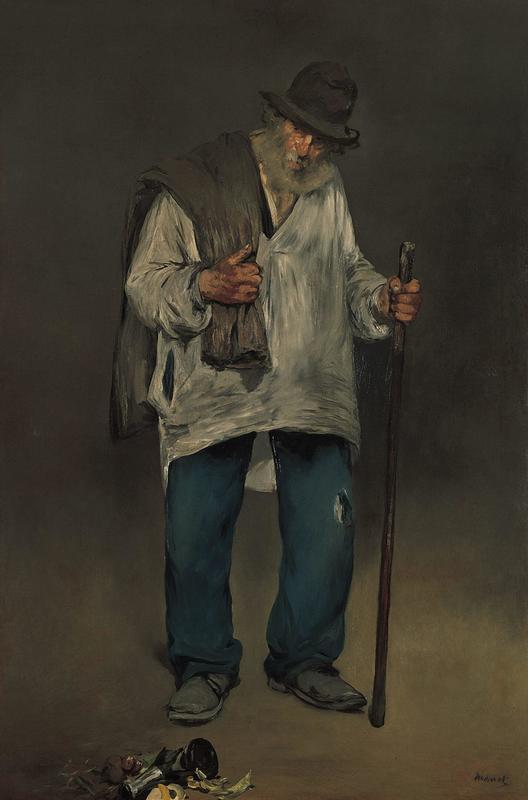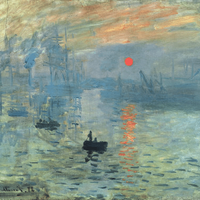More about The Ragpicker

Contributor
Edouard Manet paints a giant portrait of poverty and everyone loses their minds.
Apparently, the canvas is too big for a subject like this. This canvas is more than 6 feet long and 4 feet wide. Painting a raggedy man on a canvas of such size was considered unthinkable. No, no, no, large canvases were saved for religious or historical figures. Not peasants. Not the downtrodden. Not those that had fallen in the cracks of a new industrial society. This side of society was best left hidden, not projected on a canvas one could not physically avoid.
Alas, Manet rebelled against contemporary art by painting The Ragpicker, who occupied the outskirts of modern Parisian society. The backlash didn’t cause Manet to blink. Armed with the intention of painting modern life, Manet took notice of these people. They dwelled near his studio in the Batignolles, which sat in a poor area of the neighborhood. If you were an artist in the mid to late 1800s, Batignolles was the sight of celebrity spotting, where you’d catch Emile Zola and Charles Baudelaire frequenting local cafés.
Before moving on to the brightly lit images of Impressionism, Manet dwelled in the dumps with Paris’ downtrodden citizens. Manet was determined to paint everyday scenes. The Ragpicker isn’t the first of its kind. He met many characters hanging around the neighborhood of Batignolles. The model Laure, the black woman who posed for Manet’s Olympia, lived near Manet in Batignolles.
Batignolles was not filled only with the creative types. The neighborhood experienced a facelift in the 1860s and 1870s. The construction of new apartment buildings, and the installation of a railroad allowed for a mix of people to live amongst the new and old of Batignolles. There would remain abandoned lots and warehouses in the neighborhood, harboring gypsies, ragpickers, and Italian and Polish immigrants. Manet would use them all as models.
The subject of The Ragpicker came from Batignolles. Despite being a dandy, Manet was determined to paint modern Parisian life. As an artist, Manet was an outlier to the conventional times of France. Manet senior intended for his son to have a conventional career in law. While Manet was no fit for an orthodox lifestyle, no one would believe Manet to fit in with the ragpickers, gypsies and immigrants dwelling in Batignolles. Manet moved through the streets dressed like a peacock rather than a ragpicker, going all out for the top hat, frock coat, yellow suede gloves, and walking stick.
Sources
- Campbell, Rebecca, “It Speaks to me: Rebecca Campbell on Edouard Manet’s ‘The Ragpicker’ at the Norton Simon,” The LA Times, March 30, 2011. Accessed August 20, 2019 https://latimesblogs.latimes.com/culturemonster/2011/03/it-speaks-to-me…-
- Duret, Theodore, Manet and the French Impressionists. Franklin Classics
- Herbert, Robert L., Impressionism: Art, Leisure, and Parisian Society, New Haven: Yale University, 1988.
- Historical Museum of the Urban Environment, “le Chiffonnier (The Ragpicker).” Accessed August 20, 2019 http://www.mheu.org/en/timeline/philosopher.htm
- Hossenally, Rooksana, “Parisian Walkways: Laid-Back Batignolles,” France Today, February 9, 2015. Accessed August 28, 2019. https://www.francetoday.com/culture/shopping-boutiques/parisian_walkway…
- Glasberg, Eve, “Posing Modernity: Wallach Gallery Rethinks the Black Model’s Role in Modernism,” Colombia News, October 17, 2018. Accessed August 28 2019. https://news.columbia.edu/news/posing-modernity-wallach-gallery-rethink…
- King, Ross, The Judgement of Paris: the Revolutionary Decade that Gave the World Impressionist, London: Pimlico, 2007.
- Rea, Naomi, “A Student Thesis Has Become a Groundbreaking Show About How Black People Have Been Pictured Across Art History,” Artnet News, September 26, 2018. Accessed August 28 2019. https://news.artnet.com/exhibitions/posing-modernity-wallach-musee-orsa
- Stamberg, Susan, “Two Mantes, A Makeover and a Mystery,” NPR, June 16, 2009. https://www.npr.org/2009/06/16/105158824/two-manets-a-makeover-and-a-my…













I believe "The Ragpicker" by Edouard Manet is one of those pieces that carry enough weight to make a statement on its own. It depicts a man who is visibly poor, wearing dirty, ragged clothes and standing next to a pile of trash. This is very different from Manet's usual paintings which depict wealthy-looking women, the bourgeoisie, and all sorts of people with some sort of ease in the way that they live. For instance, his painting Nana, depicts a woman beautifully dressed, standing in front of her mirror while doing her makeup. This is an indicator that she could afford the beauty products she was using and was also living a life that allowed her to have time for such things, so she was neither a maid nor an employee in a factory. There is also a man in the corner, looking like he was begging for her attention, which shows that the goal of that portrait was to place all the attention on Nana and her beauty. The vivid colors that were used in it are also an indicator that the painter wanted to communicate a certain sense of how alive Nana was. However, the ragpicker is displayed as the emblem of poverty as he represents the poor man of that society. It was painted in 1869, ten years after a painting he called "The Absinthe Drinker" which also depicted an alcoholic dressed pretty modestly. I would think the fact that the ragpicker also wears a hat was Manet's way of tying the two paintings by showing one of the possible outcomes of alcoholism: poverty. Also, since Manet has been reported to have been fascinated by Diego Velasquez, his two paintings may have been his way of paying tribute to him by making two characters out of his painting "Menippus" which depicts an old, shaggy man with a hat similar to the ragpicker, while wearing clothes like the absinthe drinker.
One of the most noticeable details about the ragpicker is the use of the dark colors. The gray scale in the background conveys a certain sense of despair and sadness, which is reflected on the ragpicker's face. The pile of trash in front of him also suggests that he is living in less than ideal conditions and probably lives off of whatever he can find and pick up off of the floor.
This painting is an eye-opener because it allowed every viewer to notice what it looks like to be living in poverty. If my theory is right and the ragpicker was Manet's way of giving us a look into the future of the absinthe drinker, then I believe this painting is also a warning to us all and a way of calling us all to use caution in the way that we drink in order to avoid alcoholism and poverty, which can be a direct consequence.